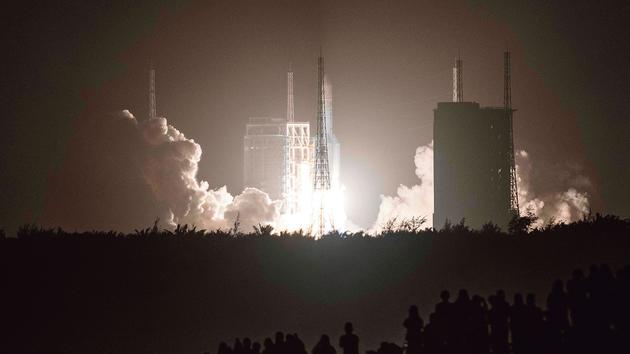China has landed (again) on the Moon!
The state television channel CGTN announced the news at 4:13 p.m. Tuesday on its website after a slight lack of communication: the video stream to follow the moon landing live on the internet was in fact cut for about fifteen minutes. before the arrival, without any explanation and leaving fear the worst ... The exact reasons for this cut are not clear to this day, the Chinese television having apparently continued to cover the event live.
Read also:
China wants to land a piece of the Moon
If this lack of international transparency is frustrating, it does not tarnish the feat, quickly confirmed by amateur radio astronomers able to directly recover the radio signal from the machine.
In the end, this is already the third time that the country has succeeded in the performance of the moon after Chang'e 3 in 2013, then Chang'e 4 (on the dark side, a world first) in 2019. Following in the footsteps of these illustrious elders, Chang'e 5 took off on November 24 aboard the powerful Long March 5 rocket with an even more ambitious objective: to bring samples of soil and lunar rocks back to Earth.
If the return to Earth was successful, China would then join the USSR and the United States in the very closed club of powers that have accomplished this feat.
"Splendid soft moon landing of Chang'e 5!"
, commented Bernard Foing, director of the international lunar exploration group of the European Space Agency (ESA).
"It is a remarkable performance of technology, work and organization of our Chinese colleagues."
Also see - China launches Long March-5 rocket ahead of its mission to Mars in 2020
But the case is not over.
China has bet on a fairly complex architecture of the Apollo type.
The idea is as follows: send a vessel weighing more than 8 tonnes whose "engine" and the atmospheric reentry capsule (which together make up the service module) remain in orbit around the Moon at an altitude of 200 km. while a lander lands on the surface.
It then weighs “only” 1.2 tonnes, which makes it easier to brake.
But this one is brutal: the module spins indeed still at 7000 km / h at 15 km of altitude a quarter of an hour before landing!
This is exactly the time it takes for the lander's rocket motors to stop it and bring it a few meters above the ground for a smooth landing.
It was this crucial step that went off apparently without a hitch on Tuesday.
A perilous end of mission
The probe will only stay on the surface for 48 hours in principle.
The sampling operations themselves will take 20 hours and were to start within hours of the moon landing.
The objective is to collect 500 grams of samples between 1 and 2 meters deep using a drill, then to collect 1.5 kg using a mechanical shovel placed at the end of an arm robotic.
The return container could however accommodate up to 4 kg of samples.
The site chosen by China is in the Ocean of Storms (Oceanus Procellarum in Latin, it is a gigantic sea located in the northwest of the visible face).
The probe landed on Tuesday a few tens of kilometers from Mons Rümker, a massif 1000 meters above sea level, a priori quite young.
"These are large hills formed by low viscosity lava flows
,
"
explains Francis Rocard, head of solar system exploration programs at Cnes, the French space agency.
“These are among the most recent traces of volcanic activity on the Moon.
They are only 1 to 2 billion years old. "
The soil and rocks in this region could be quite different from the material collected by the American Apollo missions or the Soviet Luna, all 3 to 4 billion years old.
"We hope that China will agree to send some samples to France to be analyzed in the laboratories of the CRPG in Nancy and the IPGP in Paris and others,"
says Francis Rocard.
We are under discussion. ”
In any case, it will be necessary to wait for the end of the mission which promises to be perilous.
After collection, the upper part of the lander (nearly 500 kg) must take off to find the service module which remained in orbit.
A delicate automatic appointment procedure is planned.
The two vehicles have only a few hours to meet and dock with each other.
The container must then be transferred to the return capsule, a scale model of the one that brings the taikonauts back to Earth.
After a few days in orbit to get on an optimal return trajectory, the spacecraft will then begin its return to Earth.
It will take four to five days of crossing before arriving on Earth.
Read also:
The Moon, an eighth continent to conquer
The last part of the mission, already experienced by China in 2014 with its Chang'e 5 T1 demonstrator, is also impressive.
At 5,000 km from Earth only, the service module must release the capsule for a high-risk re-entry at 45,000 km / h.
To save themselves from the development of a heat shield more complex than those used in low orbit, the Chinese have chosen to ricochet their capsule off the atmosphere to achieve initial braking.
A clever technique, but which significantly enlarges the ellipse of uncertainty for landing.
Scheduled, if all goes well, on December 16 in the desert region of Inner Mongolia.
See also - China successfully launches its first mission to bring back moon rocks
»See also - United States, China ... Who is going to plunder the Moon?

